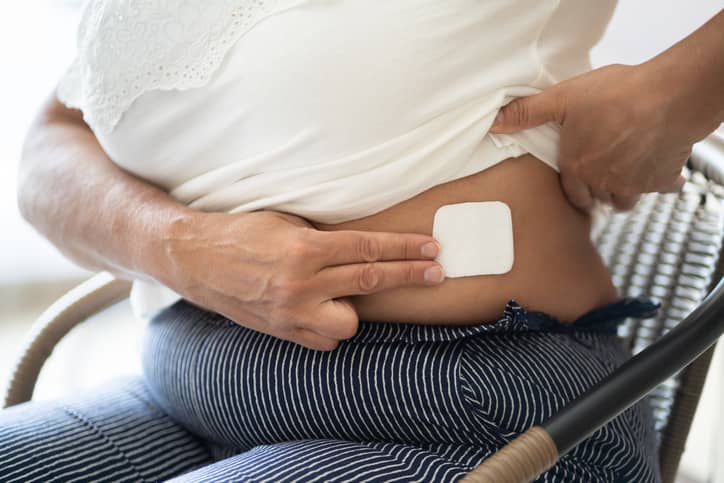Postmenopausal bleeding
Menopause is the time in your life when your periods stop. They usually become lighter and less regular over a few months or years (perimenopause), but they can stop suddenly.
When you haven’t had a period for 12 months, you’ve reached menopause. Any bleeding from your vagina after this is called postmenopausal bleeding (PMB).
Vaginal bleeding after menopause isn’t uncommon, and can range from light spotting or a pinky or brownish discharge to heavier, period-like bleeding. It’s most likely to happen in the first year after menopause.
Read on to learn about the possible causes of bleeding after the menopause, how they can be treated, and why you should always see a doctor about if you have PMB.
What are the causes of postmenopausal bleeding (PMB)?
In most cases of bleeding after menopause, the cause isn’t serious and can be easily treated. But it’s important to have any PMB checked by your doctor, as it can occasionally be a sign of cancer.
Here are the most common causes of bleeding after the menopause.
Vaginal atrophy
Postmenopause, you have lower levels of the hormone oestrogen. This can lead to thinning, drying and soreness (inflammation) of your vagina.
Known as vaginal atrophy or atrophic vaginitis, it’s the most common cause of PMB. It can also cause vaginal itching, discharge, pain during sex and bleeding after sex.
Read about other causes of bleeding after sex.
Polyps
Polyps are small growths that can develop in the neck of your womb (cervix) or lining of your womb (endometrium). They’re most common during and after the menopause and can cause vaginal bleeding.
They’re a bit like skin tags and they’re usually non-cancerous (benign).
Hormone replacement therapy (HRT)
Hormone replacement therapy (HRT) is a treatment used to reduce or prevent menopause symptoms, such as hot flushes and mood swings, by restoring your oestrogen and progesterone levels. However, it can also cause unexpected vaginal bleeding.
Depending on the type of HRT you take, you may have abnormal bleeding that is heavy, frequent or happens at any time.
Thickening of the womb lining
Known as endometrial hyperplasia, a thickened womb lining can happen when you have too much oestrogen and not enough progesterone. It usually happens after the menopause, but can also happen in the time leading up to it (perimenopause).
Having a thickened womb lining often causes unusual vaginal bleeding, such as very heavy periods during the perimenopause or bleeding after the menopause.
It can also be caused by obesity, or by taking HRT or a breast cancer medication called tamoxifen.
Fibroids
Fibroids are growths of muscle that can develop in the wall of your womb. They’re common, particularly after the age of 40. Sometimes, a fibroid may bulge into the lining of your womb and cause bleeding.
Less common causes of bleeding after the menopause
Less commonly, PMB can be caused by cancers of the endometrium, cervix, vagina or, very rarely, the ovaries.
1 in 10 people with PMB have cancerous cells in the endometrium.
Risk factors for endometrial cancer include increasing age, taking oestrogen-only HRT, going through the menopause late, high blood pressure, polycystic ovary syndrome (PCOS) and infertility.
Taking medication that thins your blood (anticoagulants) is another possible cause of vaginal bleeding after the menopause.

When to see a doctor about postmenopausal bleeding
You should call an ambulance or go to your local emergency department if you have bleeding that is very heavy or won’t stop.
You should see your doctor right away if you have any postmenopausal bleeding, as it can be a sign of cancer. Your doctor should refer you to a specialist and you should be seen within 2 weeks, so it can be checked as soon as possible.
Treatment for vaginal bleeding after the menopause
The treatment for PMB depends on the cause, as follows.
Vaginal atrophy
Thinning of the vagina is usually treated with oestrogen-like medication. The type of medication will depend on your symptoms and preference.
Your doctor can prescribe topical oestrogen, either as a cream you apply or as a tablet or ring you insert in your vagina. This restores oestrogen to your vagina.
HRT can also help with symptoms of vaginal atrophy. But because it affects your whole body, it isn’t usually recommended for this unless you have other menopausal symptoms that also need treating.
If vaginal dryness is causing discomfort, including pain during sex, vaginal moisturisers and lubricants can help.
Polyps
Polyps don’t always need treatment, especially if they’re small, and they sometimes go away on their own.
If they do need treating, they’re usually removed with surgery. Depending on their size and location, they may be removed at a day clinic using a local anaesthetic or at a hospital with general anaesthetic.

Hormone replacement therapy (HRT)
If HRT is causing postmenopausal bleeding, your doctor will discuss treatment and dosage options with you. Some people stop taking HRT because of bleeding problems.
Thickening of the womb lining
You’ll probably have an ultrasound scan to measure the thickness of your endometrium and check for any other causes of bleeding, such as polyps or ovarian cysts.
You may also have an endometrial biopsy – a simple procedure where tissue from the lining of your womb is removed and examined under a microscope. Treatment depends on the results, but isn’t always needed.
A thickened endometrium after the menopause can usually be treated with progesterone-like hormone medication, or surgery to remove the thickening.
Fibroids
If fibroids only cause minor symptoms, treatment isn’t always needed. They often shrink after the menopause, too, so any symptoms may ease or go away.
If treatment is needed, options include hormonal or non-hormonal medication, surgery to remove them, or a procedure that removes the lining of your womb (endometrial ablation).
Read more about treatment for fibroids.
Your health questions answered
What if I’m taking tamoxifen and bleed after menopause?
 Answered by: Dr Roger Henderson
Answered by: Dr Roger HendersonTamoxifen is a medication that can reduce the chance of breast cancer coming back, but it can sometimes cause the lining of your womb to become thickened. See your doctor if you’re taking tamoxifen and have postmenopausal bleeding or spotting. You’ll usually have a hysteroscopy, to check your womb for polyps or thickening of the endometrium. If thickening is found, your doctor will advise on whether you should continue on tamoxifen and if any other treatment is needed.
Key takeaways
- bleeding after the menopause, known as postmenopausal bleeding (PMB), isn’t uncommon
- in most cases it’s not caused by anything serious
- however, PMB should always be checked, as it can be a sign of cancer
- it doesn’t always need treatment, but can usually be treated with medication or surgery if necessary
- if you have any bleeding after menopause, see your doctor as soon as possible







